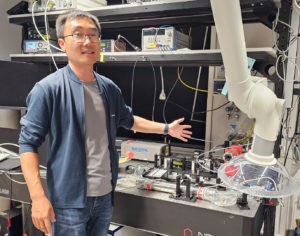On September 10th – 11th 2024, the MaritimeMET project consortium gathered in Braunschweig, Germany for the official kick-off of the project. The meeting was graciously hosted by Physikalisch-Technische Bundesanstalt (PTB), the project coordinator, in its premises at Kohlrauschbau Seminar Zentrum.
This two-day hybrid event included invited talks and presentations of the planned project activities. More specifically, Dr. Olav Werhahn, Executive Secretary of the Innovation Cluster for Environment and Climate, gave a welcome note presenting the activities from the cluster “Metrology for climate actions: From air quality to z-score evaluation”. Following that, the technical presentations of the Work Packages started with Prof. Dr. Alexander Fateev from Technical University Denmark (DTU) on WP1: Traceable emission measurements and Prof. Dr. Daniel Prades from TU Braunschweig (TUBS) bringing additional insights on low-cost sensor systems through his presentation “Integrated Light for Distributed Sensing and Metrology: Application to emission monitoring”.
In work package 2: Dynamic Pressure and Temperature were presented by Dr. Eynas Amer from the Swedish Metrology Institute (RISE) and Prof. Dr. Ing Alexander Heufer from RWTH Aachen University providing opportunities for open discussions with relevant partners. WP3: Machine learning approaches for performance optimization was showcased by Prof. Dr. Gerhard Pirker from Large Engine Competence Center (LEC) following a presentation by Mr. Piotr Strauch on white-box and black-box modelling approaches, soft sensing and the challenges from these approaches which concluded day 1 of the meeting.
Day 2 initiated with Dr. Tamara Sarac from The European Gas Research Group (GERG) giving the overview of WP4 on creating impact. After that, the coordination team presented the WP5 on the management structure and approach summarizing the event and next steps. As a highlight, the meeting participants visited the labs that take part in the project from PTB (Work Group Airborne Nanoparticle 3.43 and Working Group 3.34 Reaction Kinetics). The partners also had the opportunity to visit the Time and Frequency lab at PTB, where the optical clocks are placed.




